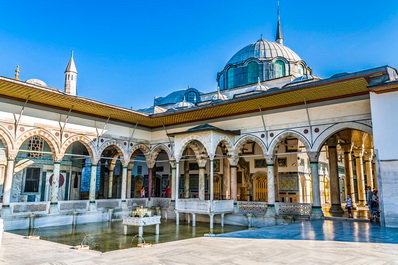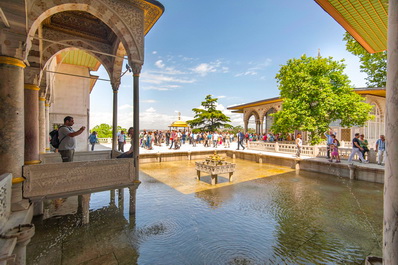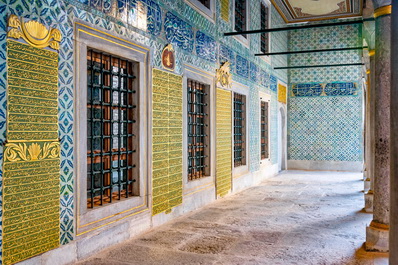
The splendid residence of Ottoman sultans in the past and now a UNESCO World Heritage Site, the Topkapi Palace (Topkapı Sarayı) in Istanbul, has no true equal in the world. Something of a castle and even a fortress, it embodies the very spirit of Ottoman architecture of the medieval age. When witnessing its treasures, you sense majesty and restraint, elegance and power. So, it is no wonder that for centuries, travellers to Turkey (Türkiye) have been captivated by its graceful courtyards, pavilions, and sweeping views across the Bosphorus.
In this guide, you will find all you need to plan your visit – Topkapı Palace Museum tickets, opening hours, and the best time to explore. You will also uncover the palace’s fascinating history and learn what to see inside, from its imperial artefacts to the hidden chambers of the legendary Harem.
To continue your journey through Istanbul, discover more of Istanbul’s top experiences.
Topkapı Palace Ticket Fees and Opening Hours

The Topkapi Palace Museum ticket costs 2,400 TL (around €50) per person. It includes entry to the Hagia Irene church (Aya İrini), the Imperial Harem (Harem-i Hümayûn), the clock and weapon collections, pavilions, and an audio guide. Tickets are valid for one day from the date of purchase.
Children under six years old enter for free, while students receive a discount upon presenting their ISIC (International Student Identity Card).
The Topkapi Palace opening hours are 09:00am–6:00pm, for all sections and seasons, according to the official museum network muze.gen.tr. Ticket offices operate from 09:00am–5:00pm. The palace is closed on Tuesdays and the first day of Ramadan Bayram (Ramazan Bayramı).
Tickets are sold on-site at the main ticket booth of the First Courtyard, near the gate leading to the Second Courtyard. You can also use the self-service ticket kiosks to pay by card, which is faster and helps bypass the long entrance lines. There is a side entrance close to the Istanbul Archaeological Museum (İstanbul Arkeoloji Müzeleri). It can be reached on foot via Gülhane Park (Gülhane Parkı).
Tourists can purchase an Istanbul e-pass to visit several other city landmarks.
When planning your itinerary, consult our guide to things to do in Turkey to uncover the country’s most curious historic and natural attractions.
Tips and Practical Information

The best time to visit the Topkapi Palace in Istanbul is early morning or late afternoon (2-3 hours before closing). The off-season months, from November to March, and the mid-season months, from March to May, are the best times to escape crowds and enjoy a relaxed atmosphere.
Not all areas are wheelchair accessible. Sections such as the Harem, Treasury, and certain terraced pavilions can be challenging due to uneven ground.
How to get to the Topkapi Palace? To reach the palace, take the T1 Tram Line to Sultanahmet Station. Then, it is a short walk. The main entrance is directly opposite Hagia Sophia (Ayasofya-i Kebir Cami-i Şerifi). You can easily pay for the tram and other public transportation in Istanbul using an Istanbul Card (İstanbulkart), a rechargeable smart card valid on trams, buses, metro lines, ferries, and funiculars.
Bring your headphones and a fully charged smartphone to use the audio guide. Please note that security checks are in place: large bags, backpacks, and food or drink (except bottled water) are not permitted inside the venue.
Sightseers can dine at Konyalı Restaurant or the Coffee Shop next to the Imperial Gate within the palace grounds. Alternatively, they can choose from the many cafés and restaurants around Sultanahmet and try authentic Turkish food.
Allocate at least two to three hours for the visit. Still, many travellers prefer to spend the entire day scrutinising the complex.
Wear comfortable shoes and light clothing, especially in summer, as the courtyards can get extremely hot.
For official updates on the museum hours or ticketing, consult muze.gen.tr or millisataylar.gov.tr. However, as online information may occasionally be outdated, it is wise to confirm with the museum before visiting.
Did you know? In October 2025, the historic cat door of Topkapi was reopened, welcoming back the palace’s long-time feline residents. For centuries, cats have roamed the courtyards and gardens, regarded as guardians of the complex and a beloved part of Istanbul’s heritage.
This tradition reflects the city’s deep appreciation for animals and hospitality – key elements of Turkish culture and daily life.
Topkapi Palace Tours

A guided tour of Topkapi Palace opens the gates to the private world of the Ottoman sultans. Expert guides bring to life the stories behind the gilded halls, royal pavilions, and the mysterious Harem. Those short on time can choose skip-the-line tours to avoid long queues that often form during peak season.
Combo tours combine the Topkapı Palace with the nearby Hagia Sophia (Ayasofya), the Blue Mosque (Sultanahmet Camii), and the Basilica Cistern (Yerebatan Sarnıcı). It is best suited for first-time visitors to Istanbul’s Historic Peninsula.
Pairing your visit with the Dolmabahçe Palace (Dolmabahçe Sarayı) is highly recommended. Both palaces reveal how Ottoman architecture and court life evolved from classical tradition to European-inspired grandeur. Such contrasts provide a vivid window into Turkish traditions and customs that have shaped social life throughout the centuries.
In the summer of 2025, Topkapi Palace night tours resumed. Now, anyone can relish the illuminated courtyards and gardens after dark. These evening tours, from 9 pm to 10 pm, introduced by the Directorate of National Palaces (Millî Saraylar İdaresi Başkanlığı), afford a chance to browse the palace at its most atmospheric, long after the daytime crowds have gone.
To explore other remarkable destinations beyond Istanbul, browse our collection of tours across some of the world's inspiring cultural and historical sites.
Topkapi Palace History
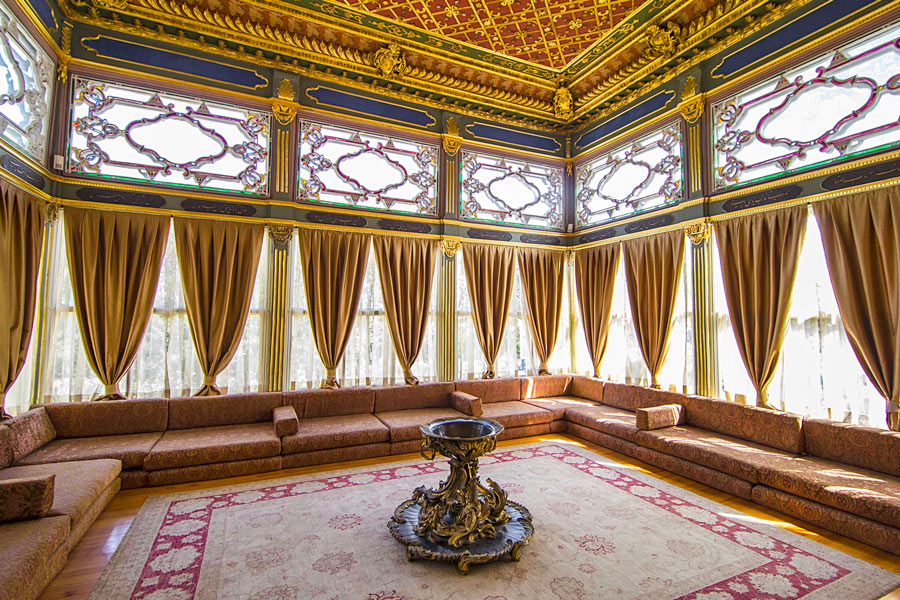
The Topkapi Palace in Istanbul has a history that dates to the second half of the 15th century, when Sultan Mehmed II (Mehmed the Conqueror, 1451-1481) ordered the construction of a new Ottoman imperial palace on the Seraglio Point, overlooking the Sea of Marmara and the Golden Horn. During the Greek and Byzantine periods, the acropolis of the ancient Greek city of Byzantium stood here. The palace became the heart of the Ottomans’ political and ceremonial life for nearly four centuries.
Between 1520 and 1560, during the reign of Süleyman the Magnificent (1494-1566), the Topkapi Palace in Istanbul underwent major expansion. The most dramatic transformation occurred in 1541 under Hürrem Sultan (Roxelana), the powerful consort and legal wife of Suleiman the Magnificent. Following a devastating fire that destroyed the Old Palace (Eski Saray) – once located on today’s Beyazıt Square site – Hürrem persuaded the sultan to transfer the Ottoman Imperial Harem to the Topkapı Palace. This decision broke tradition: according to Mehmed the Conqueror’s original decree, women were barred from residing in buildings where matters of the state were conducted. Yet the exception was made, forever changing the palace’s life.

From that point on, Topkapı became not only the administrative centre of the Ottoman Empire but likewise the official residence of the sultan, his family, and the Harem. The latter comprised nearly 400 rooms. Following Hürrem Sultan’s arrival, it became known as the New Palace (Yeni Saray). The palace was named Topkapı (Cannon Gate) in the 19th century.
By the 16th century, Istanbul’s Topkapi Palace had taken on much of the form visitors see today – a vast complex of four courtyards connected by covered corridors and surrounded by high walls ensuring privacy and silence.
The first court was open to the public, while the fourth and the Harem were the most isolated and strictly guarded. The area along the shoreline, once the Fifth Courtyard, was largely destroyed over time. The only surviving structure is the Basketmaker’s Kiosk, built in 1592 by Sultan Murad III.
The design of this palace, built for the Ottoman sultans, reflects a sense of order, restraint, and seclusion. In fact, Sultan Mehmed II codified the observation of silence in the Kanunname Code in 1477 and 1481. It concerned the inner courtyards and shaped the entire complex's architecture and atmosphere.
Sultan Abdülmecid I (1839-1861) relocated the imperial residence to the newly built Dolmabahçe Palace on the Bosphorus in 1856. This move symbolised the empire’s shift towards Western tastes and the grandeur of Baroque and Rococo architecture, which had become fashionable among Europe’s aristocracy.
During the time of Abdülmecid, the tradition of showcasing precious artefacts to foreigners emerged. The Topkapi Palace was officially declared a museum by Mustafa Kemal Atatürk on April 3, 1924, following the dissolution of the Ottoman Empire in 1922.
What to See Inside the Topkapi Palace Museum?
If you wonder what to see in the Topkapi Palace Museum (Topkapı Sarayı Museum), prepare for the journey through centuries of Ottoman splendour. The complex (kulliye) is arranged around four main courtyards and numerous structures. Each reveals a different facet of palace life. From the Imperial Council halls to sacred relics and the secluded Harem, every corner of the Topkapi Palace Istanbul, tells a story of power, devotion, and artistry.
1st Courtyard: Outer Section or Birûn
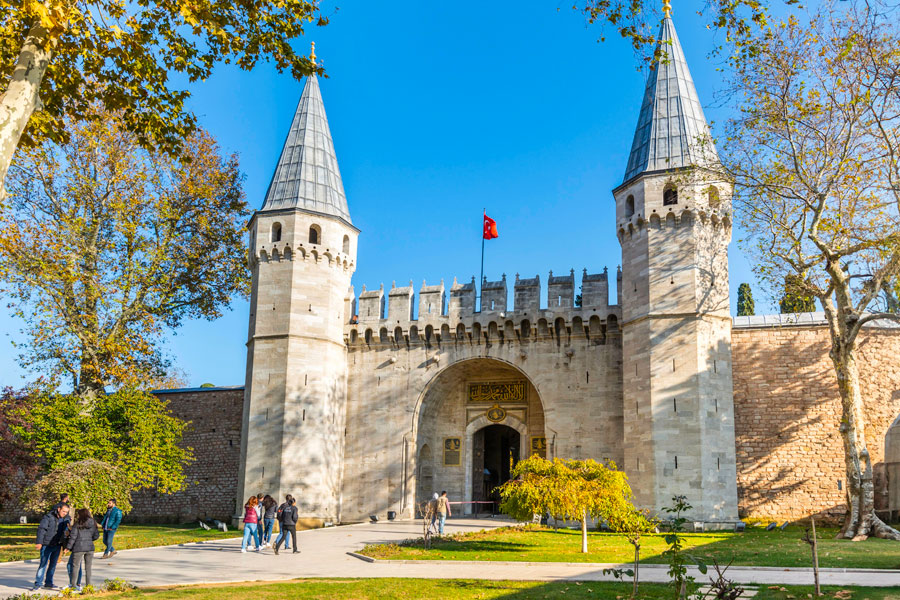
Imperial Gate (Bâb-ı Hümâyûn) marks the entrance to the First Courtyard (I. Avlu/Alay Meydanı). Things to see here are the Imperial Mint (Darphane-i Âmire) and the Byzantine Church of Hagia Irene (Aya İrini) – both integral parts of the Topkapi Palace highlights. Take a moment to appreciate the vastness of the open space. It was often used for special processions and ceremonies.
At the far end stands the Gate of Salutation (Selâm Kapısı) or Middle Gate (Orta Kapı), whose pointed towers recall the medieval European castles. This gate leads into the Second Courtyard.
2nd Courtyard: Council Hall
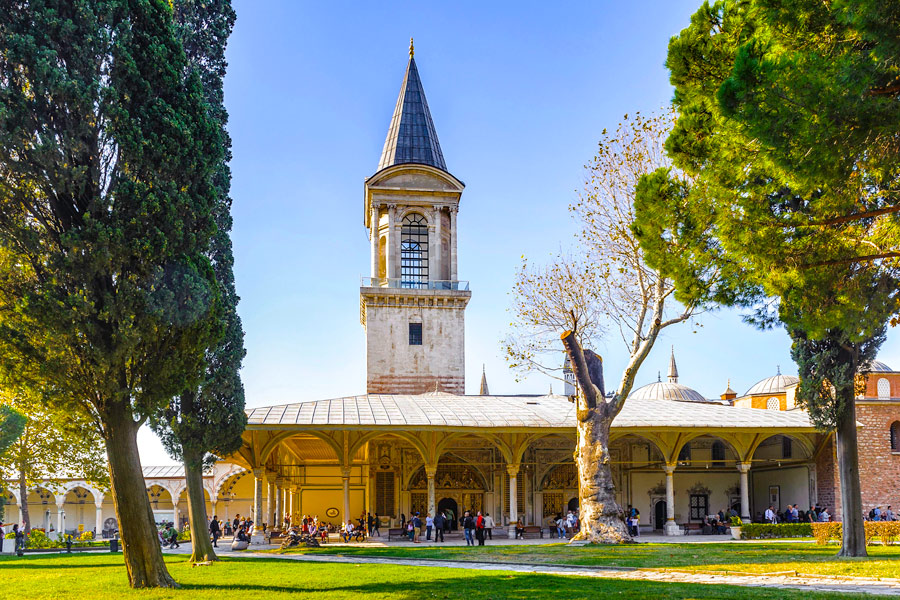
The Second Courtyard (II. Avlu), or Divan Square (Divan Meydanı), is where the administrative heart of the Ottoman imperial palace once beat. Visitors will notice the building of the Imperial Council (Dîvân-ı Hümâyûn). Here, high-ranking officials met to discuss matters of state. The sultan would observe these meetings from the Tower of Justice (Adalet Kulesi), listening unseen as the grand vizier presided over the council’s deliberations.
The courtyard is home to the Palace Kitchens (Saray Mutfakları) and confectioneries, which feature a superb collection of porcelain, including exquisite pieces from China, Japan, and other regions. During Ottoman times, the kitchen was also used to produce soap and herbal remedies.

The Outer Treasury (Dîvân-ı Hümâyûn Hazinesi / Hazine-ı Âmire/Dış Hazine) houses the Weapon Section Exhibition Hall (Silah Seksiyonu Sergi Salonu), spanning the 7th to the 20th century. These exhibitions rank among the top Topkapi Palace sights for history enthusiasts.
The section of the Imperial Stables (Has Ahırlar) has recently been turned into a clock museum. It displays various clocks, watches, and watchmaking tools. The curious item among them is the oldest 16th-century clock made in Turkey.
3rd Courtyard: Inner Palace or Enderûn

Passing through the roofed Gate of Felicity (Bâbüssaâde or Bab-üs Saadet) brings you into the Third Courtyard (III. Avlu), sometimes referred to as the Inner Palace (Enderûn Avlusu).
The most intriguing part of the Topkapi Palace Istanbul is the Imperial Harem (Harem-i Hümayûn), adjacent to the second and third courts. The sultan’s mother (the valide sultan), concubines, his children and their attendants lived in a secluded world of their own. The Courtyard of the Harem Eunuchs (Harem Ağaları Taşlığı) and the quarters of the royal pages were also located here. It was a separate area with private hammams and schools.

The first building to visit in the Topkapı Palace is the Audience Chamber beyond the Gate of Felicity. Also called the Chamber of Petitions (Arz Odası), it served as the sultan’s audience chamber for foreign ambassadors.
The Imperial Treasury (Hazine-i Âmire) is set within the Conqueror’s Kiosk (Fatih Köşkü). It contains priceless treasures from the Topkapi Palace that once belonged to the sultans. Among them are jewelled swords, ornate daggers, and the world-famous Spoonmaker’s Diamond (Kaşıkçı Elması). The Dormitory of Campaigners holds an impressive collection of royal garments. And the Dormitory of Royal Pages (Hasoda Koğuşu) is home to the Imperial Portraits Collection (Padişah Portreleri Sergi Salonu).
The Topkapı Palace Museum is a pilgrimage site for many Muslims worldwide. Its Privy Chamber (Has Oda), designed by Mimar Sinan (Koca Mi'mâr Sinân Âğâ) under Sultan Murad III, preserved the Sacred Relics (Kutsal Emanetler Dairesi) in the Privy Room (Has Oda) – including the cloak of the Prophet Muhammad and the swords of the first four califs.
Adjacent to each other are the Privy Chamber of Ahmed I (I. Ahmed Has Odası) and the Privy Chamber of Ahmed III (III. Ahmed Has Odası). The latter is also known as the Fruit Room (Yemis Odası). Both Chambers are exquisitely decorated with İznik glazed tiles, nacre, mother-of-pearl, and ivory inlay.
While visiting the Topkapi Palace Harem, stroll the 15th-century Golden Road (Altınyol). The sultan walked this corridor to access the harem.
4th Courtyard: Best Vantage Points Over the Bosphorus

The Fourth Courtyard (IV. Avlu), also known as Hasbahçe (Private Gardens), was a place of pleasure and retreat. From the time of Mehmed the Conqueror, sultans transformed these grounds into tranquil parks with kiosks, pavilions, and fountains. Gardening was a royal passion. Flowers, such as roses, violets, and tulips, flourished here. The tulip's popularity even inspired the celebrated Tulip Era (1718-1730), with royal gardens reaching their peak of beauty.
Landmarks to spotlight here are the Circumcision Chamber (Sünnet Odası), the Baghdad Kiosk (Bağdat Köşkü), and the Yerevan Kiosk (Revan Köşkü). One of the notable chambers is the Iftar Kiosk (İftariye Köşkü). Here, sultans would break their Ramadan fast during summer while gazing over the Bosphorus.
Travellers interested in nature and open spaces should also explore Turkey’s most scenic natural areas, parks, and regions to unveil the country’s diverse landscape.
Topkapi Palace Images
Within the walls of the Topkapi Palace in Istanbul, visitors encounter a living chronicle of the Ottoman Empire. Browse these photos below to glimpse the palace’s splendour and let them inspire you to witness this UNESCO World Heritage Site in person.


